Book contents
- Frontmatter
- Contents
- Preface
- Acknowledgements
- Note on mathematics and model codes
- 1 Prelude to modeling coastal basins
- 2 Currents and continuity
- 3 Box and one-dimensional models
- 4 Basic hydrodynamics
- 5 Simple hydrodynamic models
- 6 Modeling tides and long waves in coastal basins
- 7 Mixing in coastal basins
- 8 Advection of momentum
- 9 Aspects of stratification
- 10 Dynamics of partially mixed basins
- 11 Roughness in coastal basins
- 12 Wave and sediment dynamics
- References
- Index
- References
9 - Aspects of stratification
Published online by Cambridge University Press: 18 December 2009
- Frontmatter
- Contents
- Preface
- Acknowledgements
- Note on mathematics and model codes
- 1 Prelude to modeling coastal basins
- 2 Currents and continuity
- 3 Box and one-dimensional models
- 4 Basic hydrodynamics
- 5 Simple hydrodynamic models
- 6 Modeling tides and long waves in coastal basins
- 7 Mixing in coastal basins
- 8 Advection of momentum
- 9 Aspects of stratification
- 10 Dynamics of partially mixed basins
- 11 Roughness in coastal basins
- 12 Wave and sediment dynamics
- References
- Index
- References
Summary
Solar heating
Solar radiation
Much of the modeling of coastal basins is a study of currents, turbulence, and mixing, some part of which is due to temperature gradients produced by heating from the Sun. The Sun is a driving mechanism for most of the dynamics of the oceans and atmosphere and we feel its effect in coastal basins not only through solar heating but through winds, barometric pressure, regional currents, rainfall, and river flow. The Sun is not the only source of energy on our planet: we also have energy released by geological processes, fueled by the heat inside the Earth's mantle, and the effect of terrestrial processes some of which are induced by humans.
Solar energy, i.e., heat from the Sun, strikes the upper atmosphere as radiation of short wavelength (visible light, ultraviolet light, and even higher-energy radiation and particles) at an average rate near 1367 W m−2 and is returned back into space as infrared radiation (or as reflected short-wavelength radiation). In a steady state the inward and outward heat fluxes are equal. The intensity of the incoming radiation from the Sun is fairly constant at the top of the atmosphere although there is some variation over the year due to the Earth's orbit, and variations on longer timescales which have a major influence on the long-term variability of climate. The average temperature of the Earth (the oceans, atmosphere, and land) is nearly constant, and so the Earth's heat budget is in an approximate steady state.
- Type
- Chapter
- Information
- The Dynamics of Coastal Models , pp. 320 - 348Publisher: Cambridge University PressPrint publication year: 2008



